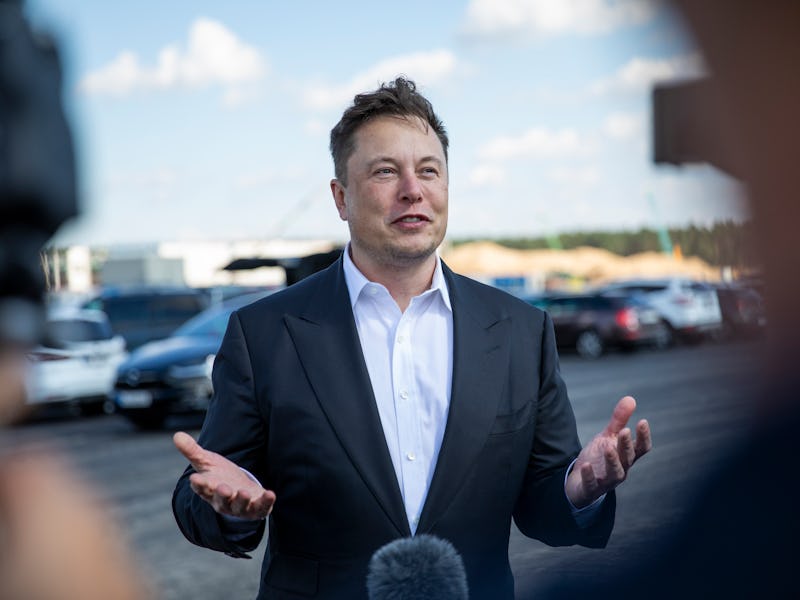Tesla's Elon Musk lays out how to transition Earth to clean energy
Tesla CEO Elon Musk has a plan for humanity to ditch fossil fuels for good.

Elon Musk wants to move humanity away from fossil fuels and onto renewable energy sources, and he has a plan to get it done.
The Tesla CEO has spoken before about his goal to end what he calls the "dumbest experiment in human history." This month he proposed how society could transition all its energy usage toward sustainable sources. The plan, outlined at the company's Battery Day on September 22, involves massively increasing battery production.
More batteries mean more places to store electricity. That also means more ways to use electricity from intermittent sources like solar and wind. When a solar panel generates electricity during sunshine, or a wind turbine on a gusty day, a battery can help provide that clean energy 24 hours a day. It can then be used in homes and businesses – or even transferred to other batteries, like in electric cars.
"To accelerate the transition to sustainable energy, we need to produce more [electric vehicles], they need to be affordable," Musk said during the on-stage presentation at the Tesla Design Studio. "And a lot more energy storage, while building factories faster and with far less investment."
Declaring that "tera is the new giga," Musk explained how society needs to produce batteries on the order of Terawatt-hours per year. Battery production in 2019, according to Musk, measured 0.1 Terawatt-hours for electric cars and 0.006 Terawatt-hours for other uses. The sources for these figures were electric vehicle database EV-Volumes and analysis firm IHS Markit.
Tesla's battery projections.
We're going to need a lot of batteries – Reaching fully electrified transport, Musk suggests, would require a 100-fold increase in production to 10 Terawatt-hours. This would cover 1,500 gigawatt-hours for small cars, 3,500 gigawatt-hours for midsize cars, 900 gigawatt-hours for luxury cars, 1,100 gigawatt-hours for pickup trucks, and 3,000 gigawatt-hours for commercial uses.
Tesla's battery projections.
In terms of fully renewable energy, battery production would need to increase 1,600-fold from its current 0.006 Terawatt-hours to also reach 10 Terawatt-hours. That would include 2,300 gigawatt-hours for non-renewable electricity, 1,400 gigawatt-hours for coal heating, 2,100 gigawatt-hours for gas heating, and 800 gigawatt-hours for oil heating. The remainder would cover 1,500 gigawatt-hours for future electric vehicles and 1,900 gigawatt-hours for future growth.
It's going to take a long time – "This is what's needed in order to transition the world onto sustainability," Musk said. He later caveated the figures by stating that the requirement could rise as more countries industrialize. Musk said the world would require battery production of 20 to 25 Terawatt-hours over the course of 15 to 20 years.
This transition could not take place overnight. Beyond the number of batteries needing to be produced, the world would also need to decommission existing fossil fuel plants. Musk noted that power plants tend to last around 25 years. That means it would take at least 25 years to transition to clean energy, even if the world stopped building fossil fuel plants tomorrow. There is some good news on that front: Musk noted that wind and solar comprised 75 percent of new capacity in the United States this year.
It's going to require better batteries – The battery production would represent a major jump from today's levels. Musk explained that Tesla's Giga Nevada facility could potentially produce around 150 gigawatt-hours total, which would mean Tesla would need 135 such factories to produce 20 Terawatt-hours per year. That would require a $2 trillion investment and 2.8 million people.
The "Terafactory" in action.
The solution, Musk explained, is advancements in battery technology. Tesla's new cell design is expected to reduce the cost per kilowatt-hour by half. These advancements would also mean the same size factory could produce 10 times more capacity per year. Tesla expects to reach three Terawatt-hours per year by 2030.
The Inverse analysis – Tesla's battery advancements map out a way of solving one of the biggest issues in climate change, but it's far from a comprehensive solution. Transitioning to renewables will require other firms to increase production, energy grids to transition away, and societies to move in the right direction.
The World Economic Forum claimed in January 2020 that three things need to happen to reach net-zero carbon emissions by 2050. There needs to be improvements in technology, changes in policy, and encouragement of grassroots demand. Musk's plan may help others identify feasible ways to make the switch, but it's still going to require global action and holding leaders' feet to the fire on promises to cut emissions.
This month, a new report from the World Meteorological Organization claimed temperatures could rise past 1.5 degrees Celsius as early as 2024. Cutting carbon can't wait.